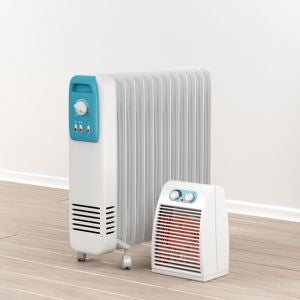As the cold sets in it’s easy to run up the heating bill. So it’s important to take what action you can to limit your heating expenses this winter and keep electricity costs down.
Canstar goes through a few steps you can take to avoid any big shocks on your winter electricity bill.
Quality insulation

As a first step, it pays to assess your insulation. A home without proper insulation isn’t easy (or cheap) to keep warm. The extent to which you can keep the cold weather out, and warm air in, will in turn limit reliance on heating.
One of the great things about insulation is that it can be easily retrofitted to a home. And often it doesn’t require a costly renovation to implement. Plus, both ANZ and Westpac currently offer interest-free loans for installing insulation and heating.
Furthermore, if you qualify for an insulation grant through the Warmer Kiwi Homes program, you can get 80% of the costs covered.
If you do intend to upgrade your insulation, be sure to shop around for several quotes, and get the help of a professional if needed.
Householders should also consider other avenues via which the cold may creep in or heat escape, such as via doors and windows.
Some steps you can take include:
- Checking hinges and catches or latches, tightening up any that are loose
- Adding weather stripping, sealing gaps around most doors or windows
- Sealing door or window trims using clear or paintable sealant
- Fitting draught excluders for gaps under internal and external doors
- Replacing damaged rubber seals around aluminium joinery
- Blocking chimneys of unused fireplaces
- Sealing gaps around extractor fans and range hoods, plumbing passages etc
The right heating methods
 It’s important to utilise the most appropriate type and size of heater for the space you want to heat, and worthwhile considering the upfront, short-term costs of a heating appliance versus the sort of costs that are likely to be accrued over the longer term.
It’s important to utilise the most appropriate type and size of heater for the space you want to heat, and worthwhile considering the upfront, short-term costs of a heating appliance versus the sort of costs that are likely to be accrued over the longer term.
How you use a room will help you to decide the type of heater that’s most suitable. For larger rooms and rooms you use regularly, it’s worth paying a bit more upfront for a fixed heater with lower running costs and more heat output than an electric heater.
A small electric heater may well be suitable for infrequent use and heating in confined spaces. It will likely cost less upfront than many other heating options. However, it should be kept in mind that it will likely be more expensive to run than other options in the longer term.
Some of the different types of heating options available to households include:
- Electric heaters – cheap to buy and good for heating smaller spaces. However a lower heat output than most other options and more expensive to run than other options
- Heat pumps – low running costs when used properly, and can be used for cooling too. Significantly higher upfront costs
- Central heating – can provide heating for your entire house. However can be expensive to install and expensive to run if a residence is not well insulated
- Modern wood burners – low running costs, especially if free or cheap firewood is available, producing very little pollution and good for heating large spaces. Can be expensive to install, and will require building consent. Plus you’ll need space to store your firewood and keep it dry
- Wood pellet burners – good for heating large spaces and providing better heat control than wood burners. However use a small amount of electricity and will not work if electricity is down. A building consent will be required for installation
- Flued gas (natural or LPG) heaters or fireplaces – also good for heating large spaces. However different gas charges should be kept in mind (such as fixed charges for reticulated supply), while a gas heater must be installed by a registered gas fitter
In determining which heating method is best suited and most economical for your household, it is worthwhile researching the pros and cons of a range of options. Both in the short and long term, and consulting heating experts.
→Related article: Simple Guide to Finding the Cheapest Power Deals
Keeping tabs on electricity usage and spend

Of course, whatever your choice of heater, you should only use it as needed, and take care not to leave it on when it is not required.
But when using it, it pays to use it correctly and as effectively as possible.
The World Health Organisation guidelines recommend a minimum temperature in houses of 18˚C, or higher for more vulnerable groups, such as children, the elderly and people who are ill. This temperature can keep you comfortable without using the extra power needed to heat the room beyond this point.
Some heating options allow you to set the temperature, which along with timers can help control your temperature and usage. And when it comes to monitoring electricity spend, many retailers provide online account management and monitoring tools. This can help you monitor your expenses and help you to adjust when necessary, or pinpoint certain appliances that may be causing big shocks to your bill.
Online account management and monitoring tools provided by retailers that may come in handy include:
- Electricity usage details – an hourly, daily, weekly or monthly record of usage over a billing period
- Real-time data – up-to-date usage and cost details
- Historical usage – usage and cost details from previous billing periods
- Graphs and tables – which can make information more accessible and potentially provide further insight into patterns of usage
- Bill estimates – the likely total cost set be accrued over a billing period
Consumers should check with their retailer to determine the sorts of tools that they have at their disposal.
Comparing electricity providers
While taking the above steps, along with several other cost-cutting strategies, can bring down your winter bills, it’s important you’re getting a good deal on the electricity you’re using. Because the power that turns on the heater is all the same, but it doesn’t all come at the same price.
If you’re unsure you’re getting the best deal, Canstar Blue can help. We rate NZ power companies for customer satisfaction and value for money, see the table below for some of the results, or you can click on the button below for the full results of our survey.
Canstar Blue’s latest review of NZ power companies compares them on customer satisfaction. The table below is an abridged version of our full results, available here.
^ By clicking on a brand or 'details' button, you will leave Canstar Blue and be taken to either a product provider website or a Canstar Blue NZ brand page. You agree that Canstar Blue NZ’s terms and conditions apply (without limitation) to your use of this service,to any referral to a product provider from our website, and any transaction that follows. Canstar Blue may earn a fee for referrals from its website tables, and from sponsorship (advertising) of certain products. Payment of sponsorship fees does not influence the star rating that Canstar Blue awards to a sponsored product. Fees payable by product providers for referrals and sponsorship may vary between providers, website position, and revenue model. Sponsorship fees may be higher than referral fees. Sponsored products are clearly disclosed as such on website pages. They may appear in a number of areas of the website such as in comparison tables, on hub pages and in articles. Sponsored products may be displayed in a fixed position in a table, regardless of the product’s rating, price or other attributes. The table position of a sponsored product does not indicate any ranking, rating or endorsement by Canstar Blue. See How we are funded for further details.
Canstar Blue NZ Research finalised in April 2023, published in June 2023.
See Our Ratings Methodology
Compare electricity providers with Canstar Blue!
About the author of this page
![]() This report was written by Canstar author Martin Kovacs. Martin is a freelance writer with experience covering the business, consumer technology and utilities sectors. Martin has written about a wide range of topics across both print and digital publications, including the manner in which industry continues to adapt and evolve amid the rollout of new technologies
This report was written by Canstar author Martin Kovacs. Martin is a freelance writer with experience covering the business, consumer technology and utilities sectors. Martin has written about a wide range of topics across both print and digital publications, including the manner in which industry continues to adapt and evolve amid the rollout of new technologies
Enjoy reading this article?
You can like us on Facebook and get social, or sign up to receive more news like this straight to your inbox.
By subscribing you agree to the Canstar Privacy Policy


Share this article